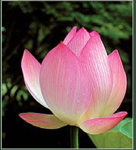
What Is the Devotional Vaishnava Sect?
Vaishnavism is an ancient Hindu sect centering on the worship of Lord Vishnu and His incarnations, especially Krishna and Rama. Largely dualistic, profoundly devotional, it is rich in saints, temples and scriptures. Aum.§
Vishnu is the infinite ocean from which the world emerges. He stands on waves, surrounded by the many-headed Seshanaga, who represents agelessness and is regarded as an extension of divine energy and an incarnation of Balarama, Lord Krishna’s brother.§
 HE WORSHIP OF VISHNU, MEANING “PERVADER,” dates back to Vedic times. The Pancharatra and Bhagavata sects were popular prior to 300 bce. Today’s five Vaishnava schools emerged in the middle ages, founded by Ramanuja, Madhva, Nimbarka, Vallabha and Chaitanya. Vaishnavism stresses prapatti, single-pointed surrender to Vishnu, or His ten or more incarnations, called avataras. Japa is a key devotional sannyasin, as is ecstatic chanting and dancing, called kirtana. Temple worship and festivals are elaborately observed. Philosophically, Vaishnavism ranges from Madhva’s pure dualism to Ramanuja’s qualified nondualism to Vallabha’s nearly monistic vision. God and soul are everlastingly distinct. The soul’s destiny, through God’s grace, is to eternally worship and enjoy Him. While generally nonascetic, advocating bhakti as the highest path, Vaishnavism has a strong monastic community. Central scriptures are the Vedas, Vaishnava Agamas, Itihasas and Puranas. The Bhagavad Gita states, “On those who meditate on Me and worship with undivided heart, I confer attainment of what they have not, and preserve what they have.” Aum Namo Narayanaya.§
HE WORSHIP OF VISHNU, MEANING “PERVADER,” dates back to Vedic times. The Pancharatra and Bhagavata sects were popular prior to 300 bce. Today’s five Vaishnava schools emerged in the middle ages, founded by Ramanuja, Madhva, Nimbarka, Vallabha and Chaitanya. Vaishnavism stresses prapatti, single-pointed surrender to Vishnu, or His ten or more incarnations, called avataras. Japa is a key devotional sannyasin, as is ecstatic chanting and dancing, called kirtana. Temple worship and festivals are elaborately observed. Philosophically, Vaishnavism ranges from Madhva’s pure dualism to Ramanuja’s qualified nondualism to Vallabha’s nearly monistic vision. God and soul are everlastingly distinct. The soul’s destiny, through God’s grace, is to eternally worship and enjoy Him. While generally nonascetic, advocating bhakti as the highest path, Vaishnavism has a strong monastic community. Central scriptures are the Vedas, Vaishnava Agamas, Itihasas and Puranas. The Bhagavad Gita states, “On those who meditate on Me and worship with undivided heart, I confer attainment of what they have not, and preserve what they have.” Aum Namo Narayanaya.§

